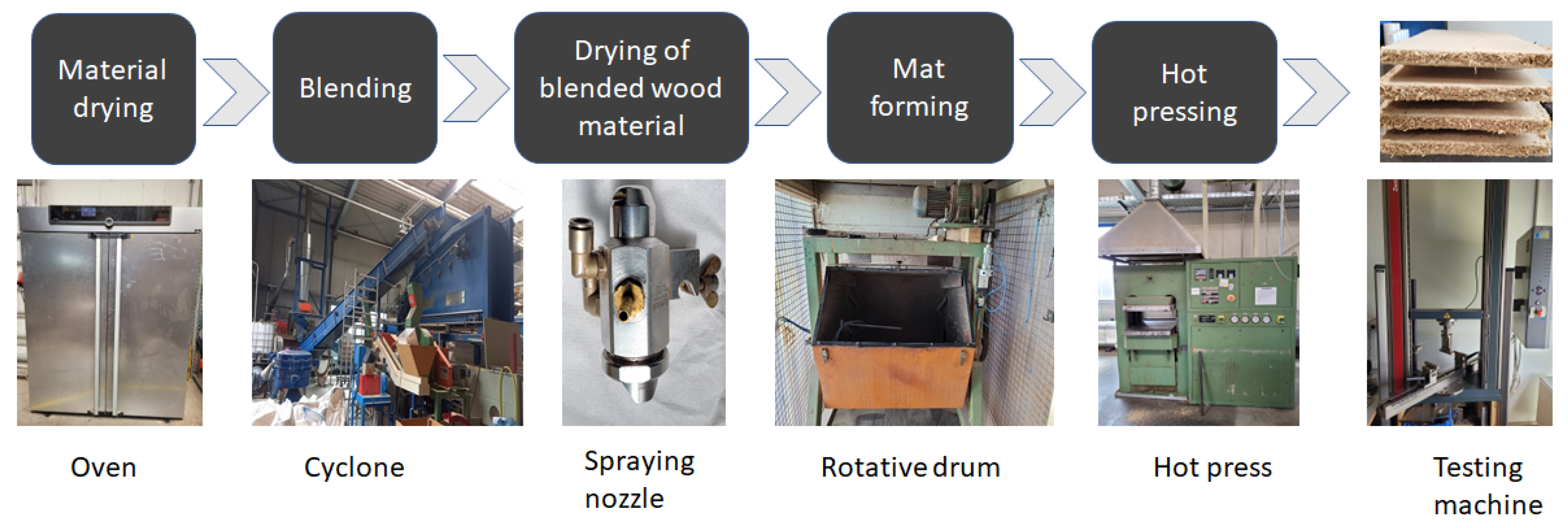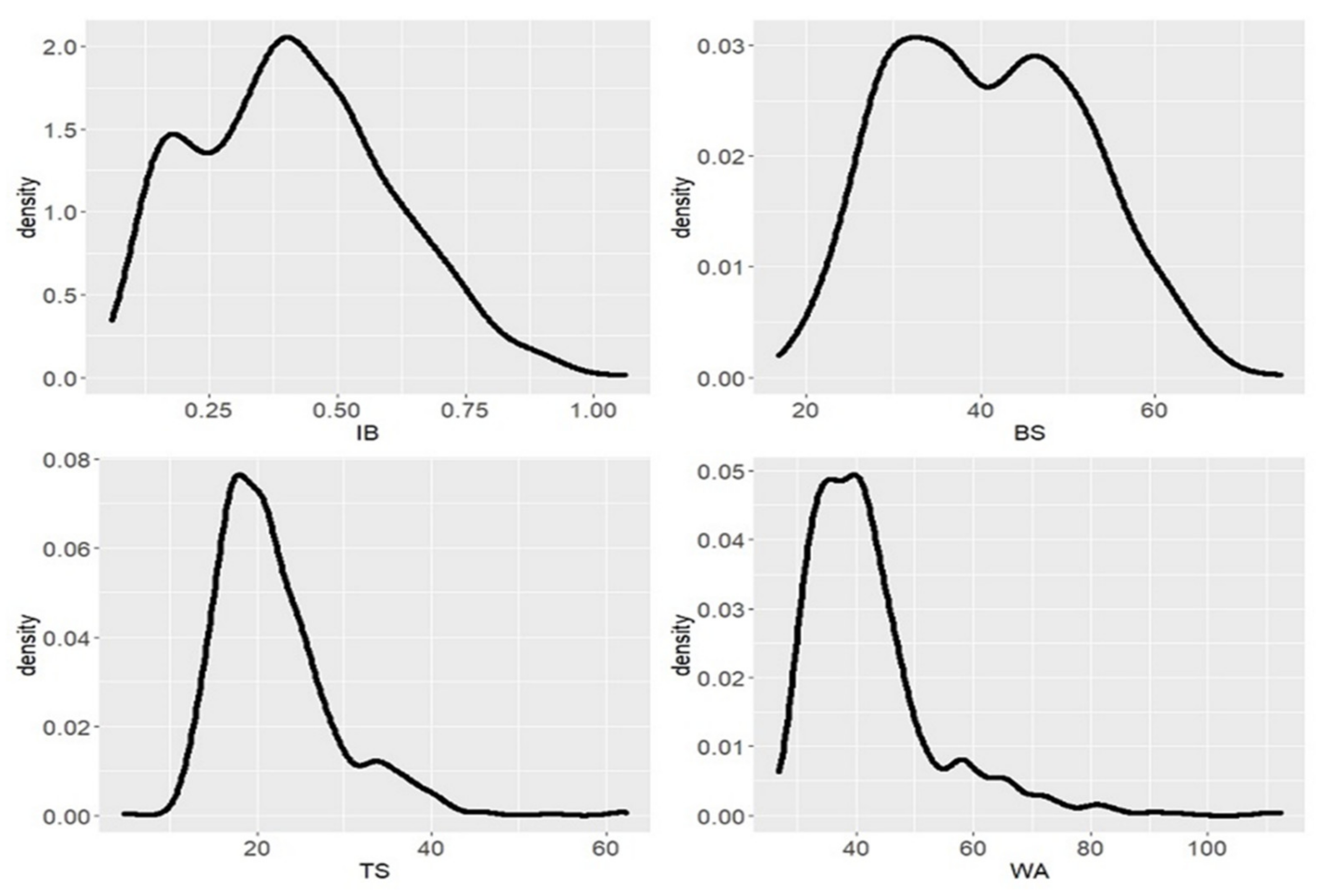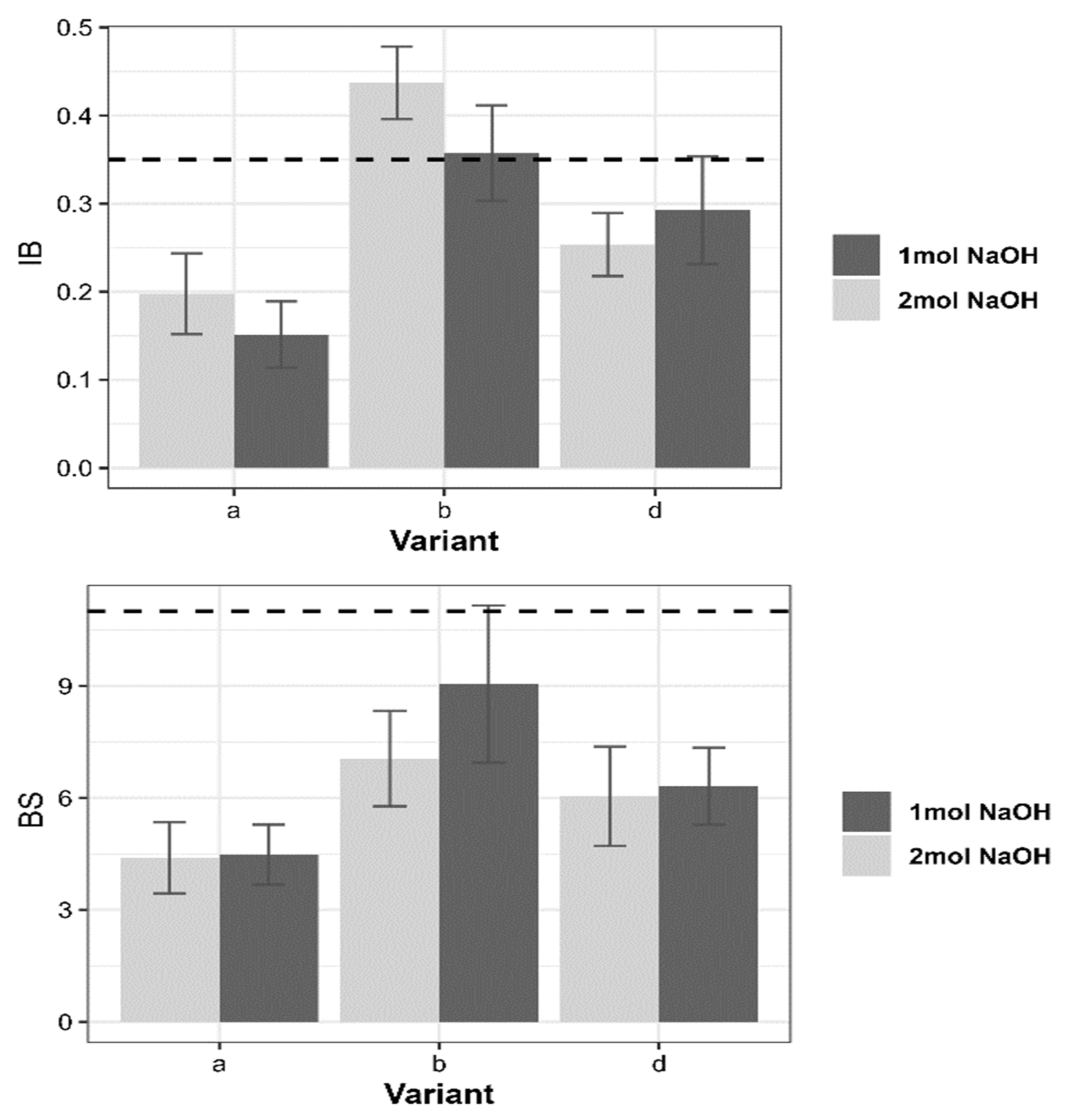Canola Meal as Raw Material for the Development of Bio-Adhesive for Medium Density Fiberboards (MDFs) and Particleboards Production
Abstract
1. Introduction
2. Materials and Methods
2.1. Material
2.2. Methods
2.2.1. Preparation of Canola Flour-Based Adhesives
2.2.2. MDF and Particleboard Production and Testing
3. Results and Discussion
3.1. Medium-Density Fiberboards
3.2. Particleboards
4. Conclusions
Author Contributions
Funding
Institutional Review Board Statement
Informed Consent Statement
Data Availability Statement
Acknowledgments
Conflicts of Interest
References
- Kennedy Vieira, R.; Kennedy Vieira, A.; Narayan Netravali, A. Application of the Rosin from White Pitch (Protium heptaphyllum) for use as Wood Adhesive. In Bio-Based Wood Adhesives, 1st ed.; CRC Press: Boca Raton, FL, USA, 2017; ISBN 9781315369242. [Google Scholar]
- Hemmilä, V.; Adamopoulos, S.; Karlssonb, O.; Kumar, A. Development of sustainable bio-adhesives for engineered wood panels—A Review. RSC Adv. 2017, 7, 38604. [Google Scholar] [CrossRef]
- He, Z.; Wan, H. Bio-Based Wood Adhesives Research Advances and Outlooks. In Bio-Based Wood Adhesives, 1st ed.; eBook; CRC Press: Boca Raton, FL, USA, 2017; ISBN 9781315369242. [Google Scholar]
- Arias, A.; Gonzalez-Rodríguez, S.; Barros, M.V.; Salvador, R.; de Francisco, A.C.; Piekarski, C.M.; Moreira, M.T. Recent developments in bio-based adhesives from renewable natural resources. J. Clean. Prod. 2021, 314, 127892. [Google Scholar] [CrossRef]
- Statista Worldwide Oilseed Production in 2021/2022, by Type. 2022. Available online: https://www.statista.com/statistics/267271/worldwide-oilseed-production-since-2008/ (accessed on 8 April 2022).
- Li, N.; Qi, G.; Sun, X.S.; Wang, D. Canola protein and oil-based wood adhesives. In Bio-Based Wood Adhesives: Preparation, Characterization, and Testing; He, Z., Ed.; CRC Press: Boca Raton, FL, USA, 2017; pp. 111–139. [Google Scholar] [CrossRef]
- Von der Haar, D.; Müller, K.; Bader-Mittermaier, S.; Eisner, P. Rapeseed proteins—Production methods and possible application ranges. Oilseeds Fats Crops Lipids 2014, 21, D104. [Google Scholar] [CrossRef]
- Feeney, R.E.; Whitaker, J.R. Chemical and enzymatic modification of plant proteins. In New Food Proteins; Alltschul, A.M., Wukcke, H.L., Eds.; Academic Press: New York, NY, USA, 1985; Volume 5, pp. 181–219. [Google Scholar]
- Li, N.; Qi, G.; Sun, X.S.; Stamm, M.J.; Wang, D. Physicochemical properties and adhesion performance of canola protein modified with sodium bisulfite. J. Am. Oil Chem. Soc. 2012, 89, 897–908. [Google Scholar] [CrossRef]
- Hale, K. The Potential of Canola Protein for Bio-Based Wood Adhesive. Master´s Thesis, Kansas State University, Manhattan, KS, USA, 2013. [Google Scholar]
- Wang, C.; Wu, J.; Bernard, G.M. Preparation and characterization of canola protein isolate-poly (glycidyl methacrylate) conjugates: A bio-based adhesive. Ind. Crops Prod. 2014, 57, 124–131. [Google Scholar] [CrossRef]
- Bandara, N.; Esparza, Y.; Wu, J. Exfoliating nanomaterials in canola protein derived adhesive improves strength and water resistance. RSC Adv. 2017, 7, 6743–6752. [Google Scholar] [CrossRef]
- Yang, I.; Jeong, J.H.; Han, G.S.; Cho, I.G.; SaGong, M.; Ahn, S.H.; Oh, S.C. Development of adhesive resins formulated with rapeseed flour akali hydrolyzates for plywood panels. J. Korean Wood Sci. Technol. 2010, 38, 323–332. [Google Scholar] [CrossRef]
- Yang, I.; Han, G.S.; Choi, I.G.; Kim, Y.H.; Ahn, S.H.; Oh, S.C. Development of Adhesive Resins Formulated with Rapeseed Flour Hydrolyzates for Laminated Veneer Lumber and Its Performance Evaluation. J. Korean Wood Sci. Technol. 2011, 39, 221–229. [Google Scholar] [CrossRef]
- Yang, I.; Han, G.S.; Choi, I.G.; Kim, Y.H.; Ahn, S.H.; Oh, S.C. Development of Adhesive Resins Formulated with Rapeseed Flour Hydrolyzates for Medium Density Fiberboard (MDF). J. Korean Wood Sci. Technol. 2012, 40, 177–185. [Google Scholar] [CrossRef][Green Version]
- Yang, I.; Han, G.S.; Ahn, S.H.; Choi, I.G.; Kim, Y.H.; Oh, S.C. Adhesive properties of medium-density fiberboards fabricated with rapeseed flour-based adhesive resins. J. Adhes. 2014, 90, 279–295. [Google Scholar] [CrossRef]
- Ostendorf, K.; Haerkötter, J.; Euring, M. Canola Meal Adhesive for the Production of Wood Fiber Insulation Boards Using Hot-Air/Hot-Steam-Process. J. Mater. Sci. Res. 2021, 10, 1. [Google Scholar] [CrossRef]
- Ostendorf, K.; Ahrens, C.; Beulshausen, A.; Tene Tayo, J.L.; Euring, M. On the Feasibility of a pMDI-Reduced Production of Wood Fiber Insulation Boards by Means of Kraft Lignin and Ligneous Canola Hulls. Polymers 2021, 13, 1088. [Google Scholar] [CrossRef] [PubMed]
- Kong, X.; Liu, G.; Curtis, J. Characterization of canola oil-based polyurethane wood adhesives. Int. J. Adhes. Adhes. 2011, 31, 559–564. [Google Scholar] [CrossRef]
- Elstner, F.; Stein, W. Entwicklung eines Verfahrens zur Gewinnung von Protein-Isolaten aus Rapssaat. Fette Seifen Anstrichm. 1982, 84, 396–399. [Google Scholar] [CrossRef]
- Hettiarqchcy, N.S.; Kalapathy, U.; Meyers, D.J. Alkali-modified soy protein with improved adhesive and hydrophobic properties. J. Am. Oil Chem. Soc. 1995, 72, 1461–1464. [Google Scholar] [CrossRef]
- Tene Tayo, J.L.; Travolta, A.; Euring, M. Use of Hardwood Species (Robinia pseudoaccacia) from Shortrotation Plantations as Raw Material in Particleboards. J. Mater. Sci. Res. 2020, 9, 2. [Google Scholar]
- Kuehler, C.A.; Stine, C.M. Effect of enzymatic hydrolysis on some functional properties of whey protein. J. Food Sci. 1974, 39, 379–382. [Google Scholar] [CrossRef]
- Khosravi, S.; Nordqvist, P.; Khabbaz, F.; Johansson, M. Protein-based adhesives for particleboards-Effect of application process. Ind. Crops Prod. 2011, 34, 1509–1515. [Google Scholar] [CrossRef]
- Nordqvist, P. Exploring the Wood Adhesive Performance of Wheat Gluten. Ph.D. Thesis, KTH Royal Institute of Technology, Stockholm, Sweden, 2012. [Google Scholar]
- Tandang-Silvas, M.R.G.; Fukuda, T.; Fukuda, C.; Prak, K.; Cabanos, C.; Kimura, A.; Itoh, T.; Mikami, B.; Utsumi, S.; Maruyama, N. Conservation and divergence on plant seed 11S globulins based on crystal structures. Biochim. Biophys. Acta 2010, 1804, 1432–1442. [Google Scholar] [CrossRef] [PubMed]




| Variant | Canola Meal (%) | Glycerine (%) | Colasol (%) | Urea (%) |
|---|---|---|---|---|
| 0 | 100 | - | - | - |
| A | 44 | 56 | - | - |
| B | 44 | - | 56 | - |
| C | 44 | - | - | 56 |
| D | 35 | 32.56 | 32.56 | - |
| E | 35 | - | 32.56 | 32.56 |
| F | 35 | 32.56 | - | 32.56 |
| G | 36 | 21.6 | 21.6 | 21.6 |
| Parameters | Board Type | |
|---|---|---|
| MDF | Particleboard | |
| Board’s target density | 800 kg/m3 | 640 kg/m3 |
| Board thickness | 10 mm | 15 mm |
| Resin load | 15% | 15% |
| Hydrowax | 1% | 2% |
| Pressing pressure | 200 bars | 200 bars |
| Pressing temperature | 200 °C | 200 °C |
| Pressing time | 6 min | 3.5 min |
| Mat moisture before pressing | 16–18% | 9–11% |
| Board per variant | 4 | 4 |
| Solvent | Variant | IB (N/mm3) | BS (N/mm3) | TS (%) | WA (%) |
|---|---|---|---|---|---|
| Water | 0 | 0.15 ± 0.04 | 38.13 ± 8.20 | 14.78 ± 1.80 | 33.35 ± 7.35 |
| a | 0.28 ± 0.14 | 35.20 ± 4.21 | 18.83 ± 2.12 | 36.09 ± 2.68 | |
| b | 0.41 ± 0.22 | 49.47± 4.70 | 16.19 ± 4.25 | 35.55 ± 6.18 | |
| c | 0.22 ± 0.10 | 29.36 ± 4.04 | 23.69 ± 3.96 | 44.96 ± 6.89 | |
| d | 0.30 ± 0.13 | 48.55 ± 5.29 | 16.61 ± 2.24 | 33.55 ± 2.53 | |
| e | 0.41 ± 0.07 | 43.99 ± 5.24 | 18.55± 2.61 | 36.27 ± 4.88 | |
| f | 0.24 ± 0.11 | 31.57 ± 4.88 | 20.62± 2.35 | 36.61 ± 3.65 | |
| g | 0.31 ± 0.08 | 41.27 ± 6.94 | 19.40 ± 2.63 | 37.10 ± 5.38 | |
| 1 mol NaOH | 01 | 0.27 ± 0.15 | 42.45 ± 5.80 | 25.87 ± 2.45 | 43.73 ± 2.45 |
| a1 | 0.35 ± 0.08 | 38.84 ± 8.06 | 19.35 ± 1.93 | 37.03 ± 3.41 | |
| b1 | 0.52 ± 0.12 | 57.06 ± 5.01 | 14.43 ± 1.08 | 32.08 ± 2.30 | |
| c1 | 0.26 ± 0.07 | 32.99 ± 3.67 | 27.97 ± 4.55 | 48.80 ± 7.58 | |
| d1 | 0.53 ± 0.10 | 55.25 ± 6.11 | 17.06 ± 2.46 | 34.58 ± 4.10 | |
| e1 | 0.49 ± 0.10 | 45.97 ± 5.64 | 17.28 ± 4.00 | 35.58 ± 4.07 | |
| f1 | 0.35 ± 0.07 | 29.73 ± 4.28 | 24.08 ± 2.73 | 45.37 ± 4.50 | |
| g1 | 0.53 ± 0.12 | 43.99 ± 5.38 | 18.39 ± 1.54 | 37.27 ± 3.96 | |
| 2 mol NaOH | 02 | 0.32 ± 0.12 | 25.32 ± 4.40 | 38.07 ± 7.90 | 73.47 ± 13.84 |
| a2 | 0.44 ± 0.09 | 32.71 ± 4.58 | 21.69 ± 1.86 | 43.54 ± 3.86 | |
| b2 | 0.81 ± 0.10 | 57.66 ± 6.22 | 18.89 ± 1.64 | 40.14 ± 2.54 | |
| c2 | 0.38 ± 0.06 | 26.90 ± 3.84 | 36.29 ± 3.64 | 66.02 ± 8.62 | |
| d2 | 0.68 ± 0.08 | 54.19 ± 5.56 | 22.90 ± 2.33 | 42.56 ± 4.05 | |
| e2 | 0.59 ± 0.10 | 46.32 ± 4.68 | 23.37 ± 3.43 | 45.45 ± 5.93 | |
| f2 | 0.43 ± 0.08 | 31.42 ± 4.65 | 28.61 ± 3.53 | 52.38 ± 6.78 | |
| g2 | 0.59 ± 0.09 | 44.65 ± 6.72 | 24.61 ± 2.74 | 45.63 ± 4.43 |
Publisher’s Note: MDPI stays neutral with regard to jurisdictional claims in published maps and institutional affiliations. |
© 2022 by the authors. Licensee MDPI, Basel, Switzerland. This article is an open access article distributed under the terms and conditions of the Creative Commons Attribution (CC BY) license (https://creativecommons.org/licenses/by/4.0/).
Share and Cite
Tene Tayo, J.L.; Bettelhäuser, R.J.; Euring, M. Canola Meal as Raw Material for the Development of Bio-Adhesive for Medium Density Fiberboards (MDFs) and Particleboards Production. Polymers 2022, 14, 3554. https://doi.org/10.3390/polym14173554
Tene Tayo JL, Bettelhäuser RJ, Euring M. Canola Meal as Raw Material for the Development of Bio-Adhesive for Medium Density Fiberboards (MDFs) and Particleboards Production. Polymers. 2022; 14(17):3554. https://doi.org/10.3390/polym14173554
Chicago/Turabian StyleTene Tayo, Jean Lawrence, Robert Jakob Bettelhäuser, and Markus Euring. 2022. "Canola Meal as Raw Material for the Development of Bio-Adhesive for Medium Density Fiberboards (MDFs) and Particleboards Production" Polymers 14, no. 17: 3554. https://doi.org/10.3390/polym14173554
APA StyleTene Tayo, J. L., Bettelhäuser, R. J., & Euring, M. (2022). Canola Meal as Raw Material for the Development of Bio-Adhesive for Medium Density Fiberboards (MDFs) and Particleboards Production. Polymers, 14(17), 3554. https://doi.org/10.3390/polym14173554






